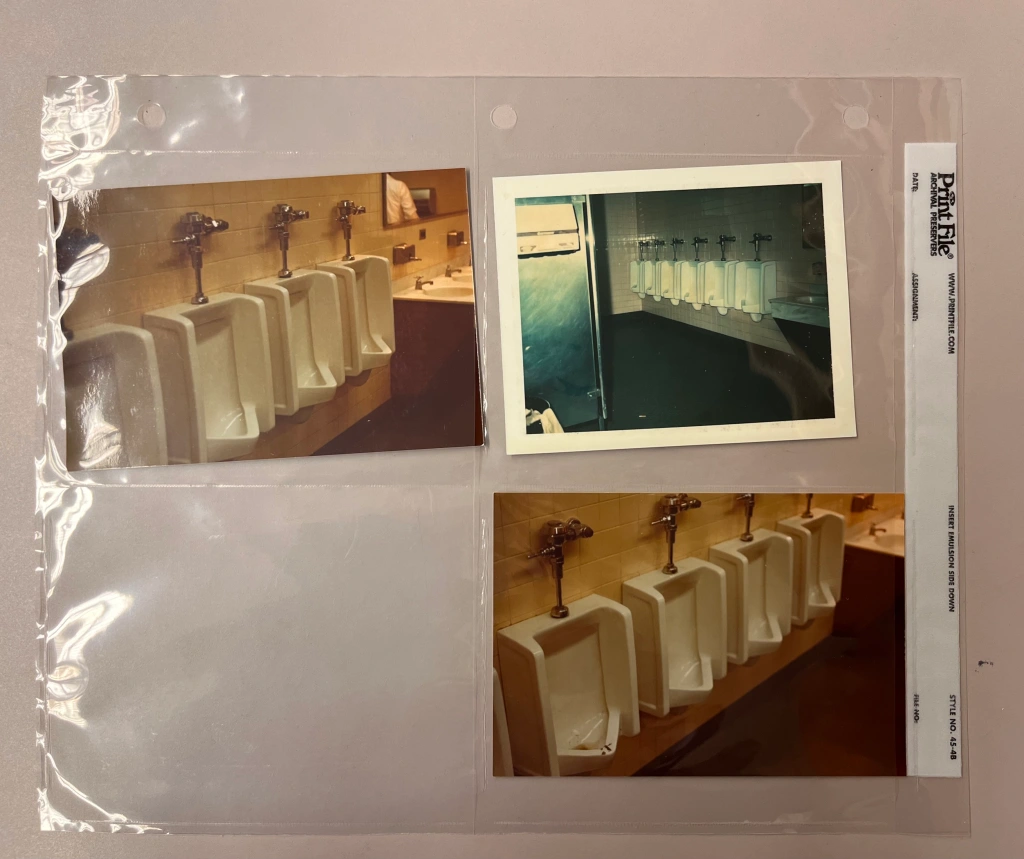Photographs from the White Plains men’s restroom, undated (from the Harris L. Kimball papers)
In the 1970s and 1980s, law enforcement across Westchester County actively and aggressively targeted men whom they believed to be engaging in homosexual contact at train station restrooms.
This, in itself, was far from new. Arrests of this nature had been a hallmark of police activity throughout the 20th century, according to Temple University professor and researcher Dr. Bryant Simon, who is currently writing a book detailing the history of public bathrooms in the United States.
“Public bathrooms offer a kind of privacy,” Simon told the Westchester LGBTQ+ History Project. “People who don’t have privacy in their personal lives discovered them almost immediately.”
As thoroughly detailed in historian George Chauncey’s award-winning work Gay New York: Gender, Urban Culture, and the Making of the Gay Male World, 1890–1940, restrooms servicing train stations served as a meeting place for men looking to meet other men beginning in the late 19th century. Police scrutiny of these spots and subsequent arrests for “public lewdness,” “sodomy” and related charges were swift to follow in metro areas.
Such was the case in Westchester, according to various local news accounts in the 1970s and 1980s. These arrests frequently included the names, ages and hometowns—sometimes even full addresses—of men arrested for these reasons.
The arrests in Westchester seem to have peaked in the summer of 1980, with widespread and targeted police campaigns at commuter rail stations including White Plains and Port Chester. Over the course of two-and-a-half months, 49 men were reportedly arrested at the White Plains train station and charged with public lewdness.
The Westchester Gay Men’s Association regularly covered these arrests in its newsletter, WGMA VOICE.

The WGMA VOICE write-ups of these events included follow-up reporting on the impacts of these arrests and the associated publicity for the men arrested. WGMA called on gay men of Westchester to take action and shared addresses where they could send letters of protest to newspaper editors and publishers. The group’s activism around this issue involved meeting with at least one local news reporter in effort to convince him to cease publishing identifying information of those arrested.
In an interview with the Westchester LGBTQ+ History Project, Simon noted that this type of self-advocacy was atypical of the time: “What’s interesting [about the situation] in Westchester is the expression of some kind of organized resistance. That, I hadn’t seen before.”
“What’s interesting [about the situation] in Westchester is the expression of some kind of organized resistance. That, I hadn’t seen before.”
Bryant Simon
The Gay Activists Alliance, an activist group based in New York City, also became involved in the fight to stop this practice. In a letter to Westchester County leaders, the group threatened to mobilize to the suburbs and protest en masse over this “vicious harassment of homosexuals.”
“We will publicly point out across the nation those responsible for the campaign,” the letter stated. “It will not be pretty.”
Speaking on behalf of the GAA, the group’s then-vice president Maurice Rosen also publicly addressed accusations that bathroom meetings between homosexual men were the result of “perversion” six years prior. “The society seems to force a kind of hiding situation where this kind of location is the only alternative,” he told the Reporter Dispatch in 1974.
Harris L. Kimball, an openly gay lawyer who practiced in Westchester, took on many of these legal cases. (In some ways, these arrests mirrored the one that he experienced personally and which served as the basis of his disbarment in Florida decades prior.) Describing the police’s tactics as entrapment, Kimball charged a White Plains City Court judge with failure to ensure the constitutional right of equal protection under the law. This prompted an investigation by a state advisory committee to the U.S. Commission of Civil Rights.
Six years prior, a police lieutenant named Ted Mooney described tactics used to arrest men for public lewdness, loitering for deviate purposes and sodomy to the White Plains Reporter Dispatch as follows:
“[Mooney’s] partner goes into the men’s room and pretends to urinate while Mooney watches through the window. Then he lingers for a few minutes. If the suspect looks at him, the officer smiles and often the suspect feels secure and may begin to masturbate. Mooney promptly arrests him.”

Leave a comment